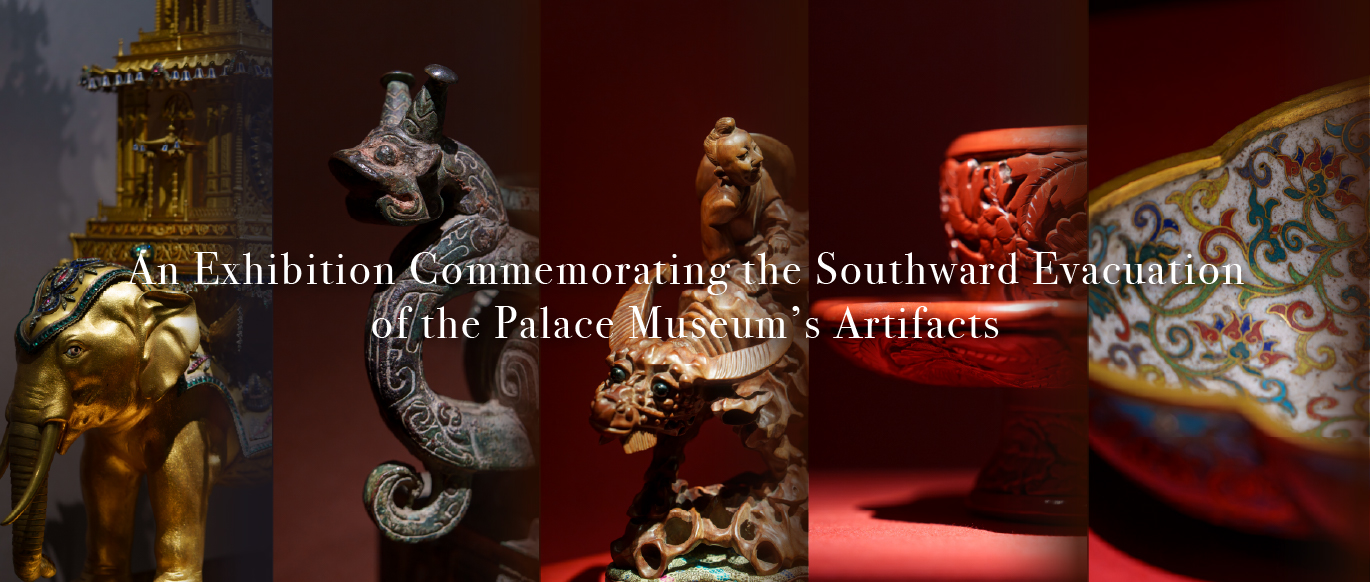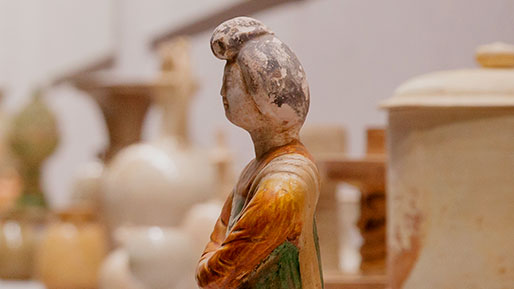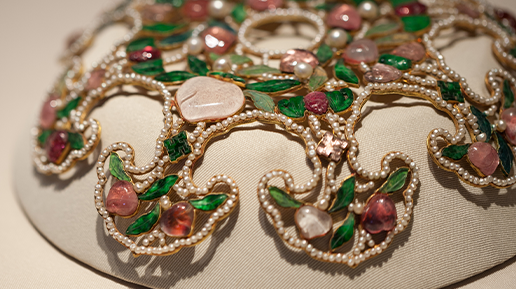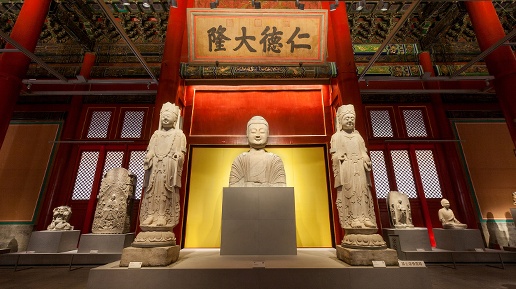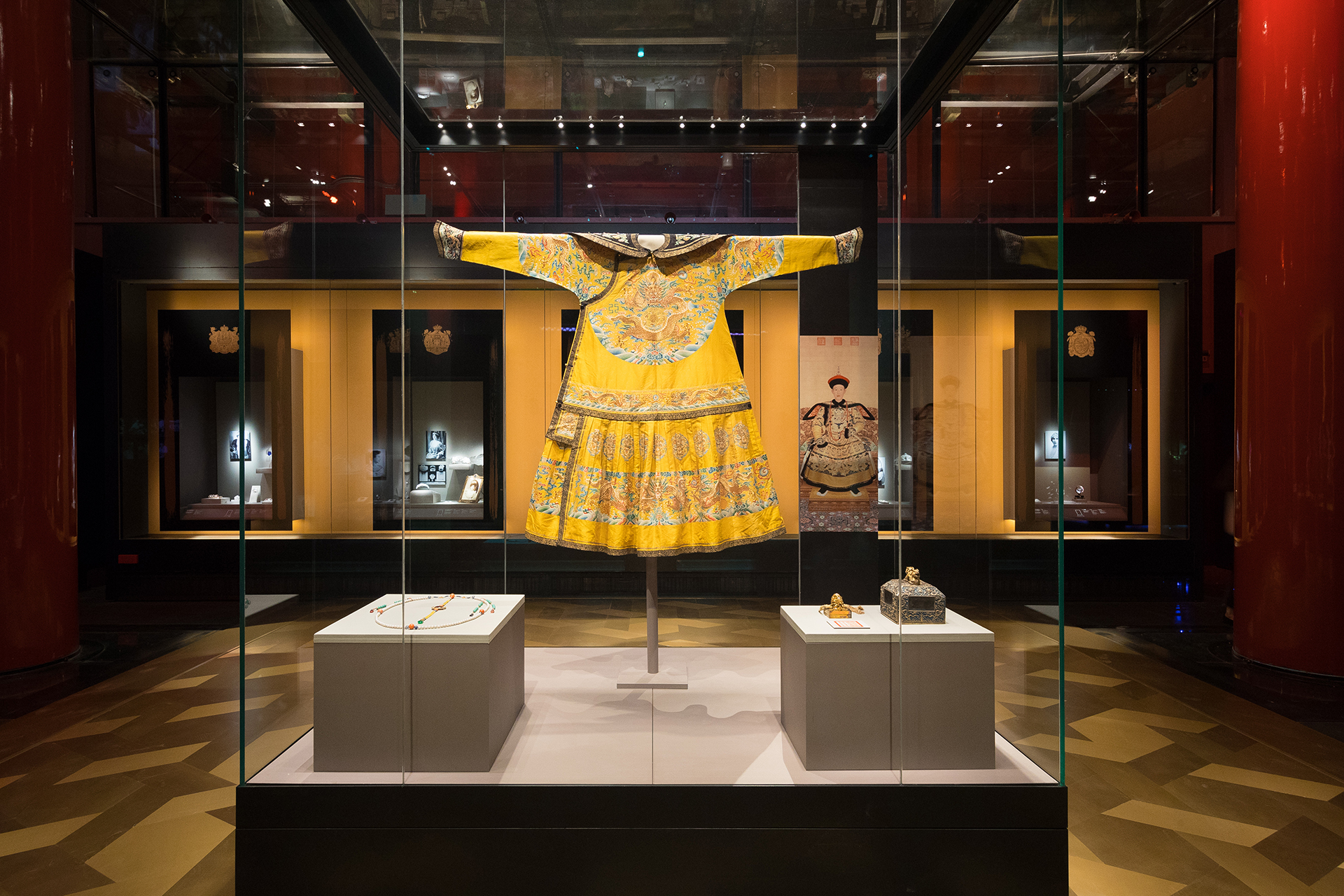
Chinese Inspirations
Cartier was founded and flourished during a changing era of globalisation and moder- nisation, at a time when China was gradually integrating itself into the world.
Under the theme Chinese Inspirations, the most representative Cartier pieces were created during the Art Deco period. The term ‘Art Deco’ itself originates from the Exposition Internationale des Arts Décoratifs et Industriels Modernes (International Exhibition of Modern Decorative and Industrial Arts) held in Paris in 1925. This international fair was held by the French government in the hope of reclaiming Paris as the world’s cultural centre. In the early 20th century, Cartier was already been a world-renowned jewellery Maison. Together with his brothers, Louis Cartier (1875-1942), the third-generation head of Cartier, led the company with revolutionary insight and innovation, successfully introducing the ‘modern style’, a predecessor of Art Deco.
With the fall of the Qing Dynasty and the dispersal of the imperial collections, many Chinese antiques were collected by Western institutions or private collectors, which directly influenced European art and culture. The time-honored ‘exotic’ Chinese culture awed and inspired European artists, who created numerous arts and crafts containing Chinese cultural elements. These inspirations hence played a crucial part in the Art Deco movement and Cartier style in the first half of the 20th century.
In a form of dialogue between the Chinese-inspired creations made by Cartier and the ancient artworks from the Forbidden City, the aim is to find a high level of mutual understanding, cultural commonality, and spiritual resonance between Eastern and Western civilizations and arts. This exhibition displays exquisite craftsmanship, ingenious Cartier designs and the refined and timeless beauty of ancient Chinese art. Here we pay tribute to great contributors to the Art Deco period, whose exceptional artwork and spirit inspire us today and will continue to do so in generations to come.

Bird of Paradise Brooch
Cartier Paris, special order, 1948
Platinum, white gold
One emerald-cut diamond weighing 2.76 carats
Two square-shaped diamonds respectively weighing 2.35 and 1.29 carats, 991 baguette-, brilliant-, and fancy-cut diamonds weighing a total of 83.89 carats
This brooch was made as a special order in 1948. The client provided the emerald-cut diamond, the two square-shaped diamonds as well as the fancy- and baguette-cut diamonds. Cartier supplied the brilliant-cut diamonds.
The exceptional dimensions (20.2 cm long, weighing 156.45 g) make this brooch a unique post-war piece of high jewelry.
Height 20.2 cm
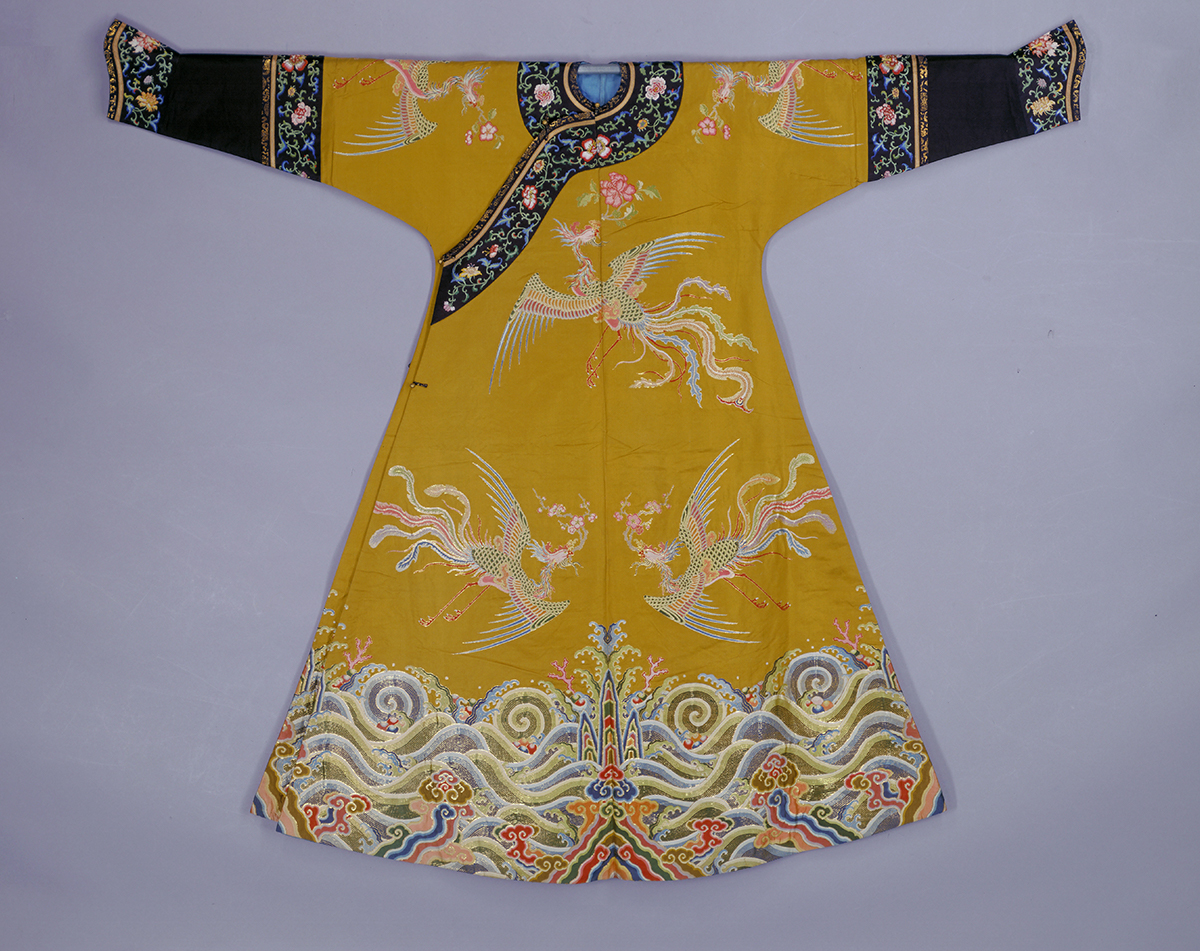
Empress\' Champagne-Colored Auspicious Robe with Flower and Phoenix Motifs
Qianlong reign (1736-1795), Qing Dynasty (1644-1911)
The Palace Museum Collection
This garment has a round collar, overlapping lapel to the right, horseshoe-shaped cuffs, and a vent at the hem on both sides. Made of champagne-colored silk, it is decorated with colorful embroidered phoenixes, either flying or looking at each other; the delicate and charming images of peony, plum blossoms, and Begonia flowers add an otherworldly atmosphere. The lower part of the garment is decorated with auspicious symbols, including sea waves, cliffs, ruyi scepter designs, and clouds. The colors are gorgeous and noble, and the craftsmanship is superb. Phoenix is a legendary auspicious bird. According to Zhuangzi Qiu Shui (Floods of Autumn): (the bird) "never resting but on the bignonia, never eating but the fruit of the melia azederach, and never drinking but from the purest springs" is regarded a symbol of nobility and good fortune.
An elegant beauty characterizes the stone-blue satin embroidered with flowers bordering the collar and cuffs, while the garment also features a white silk lining and four copper buttons in the shape of golden frogs. A cloth strip accompanying this robe reads: \'Receipt of one champagne-colored phoenix-embroidered silk robe, on the 28th day of the ninth month in the thirtieth year of the Qianlong reign\'.
The Qing Dynasty\'s rules concerning costume were established and developed over time. The Da Qing huidian (Collected Statutes of the Qing Dynasty), published in the Yongzheng reign, specified that: \'The empress’s costumes... for ceremonial robes, use yellow, greenish yellow, and quality satin\', \'for imperial concubines... yellow and greenish yellow are forbidden\'; the revised specifications in the twelfth year the Qianlong reign (1747) stated: \'For empress’s costumes... yellow is preferred, decorated with images of phoenix and pheasant\', \'for imperial consorts’ costumes, use pheasant designs... and yellow is forbidden\'; the revised Huangchao liqi tushi (Illustrated Precedents of the Ritual Paraphernalia of the Imperial Court) in 1759 (the twenty-fourth year of the Qianlong reign) mentions for the first time that \'court robes for imperial consorts use greenish yellow color\'. The clothing hierarchy of the Qing Dynasty specified colors, patterns and craftsmanship. This champagne-colored robe was made and used in the early years of Qianlong’s reign, when the Yongzheng reign system was maintained. The champagne color is also known as greenish yellow, indicating this is an auspicious robe for an empress.
Auspicious robes, by Qing Dynasty practice, were used for festivals and general ceremonies.
Body length: 144 cm; sleeve length: 180 cm; cuff width: 18 cm; hem width: 124 cm
Symbols of Power
“Cartier, Jeweller to Kings, King of Jewellers” – Edward VII
From European royalty to the illustrious names in industry, from Ame- rican high society to the Maharajas of India, from Hollywood stars to explorersandliteraryfigures,allsoughttoaffirmtheirinfluencemaintained either by right or thanks to a social or intellectual rise to power. Ideal ambassador of this need for ostentation, jewellery was chosen by all as one of the ways in which to shine in society during official ceremonies, balls or other prestigious events. It comes as no surprise that Cartier stood out as Maison of choice and that the pages of its books were filled with the most influential names of the era. Through its creations, the Maison participated in the splendour of four coronations in the United Kingdom, ceremonies which see the advent of the new sove- reign, representing the omnipotence of the monarchy. The jeweller thus confirms the importance upon which society, in all four corners of the globe, places the symbolism of jewellery and precious objects since antiquity, as the epitome of power, fashion, and emotion.
As for the Forbidden City, now the Palace Museum, which was the imperial palace of the Ming and Qing Dynasties and has a nearly 600- year history, the emperors of Dynastic China believed that the best way to govern was to follow the rites. Especially since the Ming Dynasty, peace prevailed while the court culture thrived in the establishment of rites and the promotion of aesthetic accomplishment. The Qing government had designated departments and workshops to produce attire and objects for court use. These objects, featuring conventional forms and styles, are meticulously intricate and collectively create an air of majesty that summarises the imperial life of ancient China. In order to highlight the similarity as well as the differences between craftsmanship tailored to different royal styles and tastes in Eastern and Western cultures, this exhibition gathers together pieces that best represent the imperial power of the Qing Dynasty as well as treasures created by Cartier that showcase the symbols of power of Western royal families.
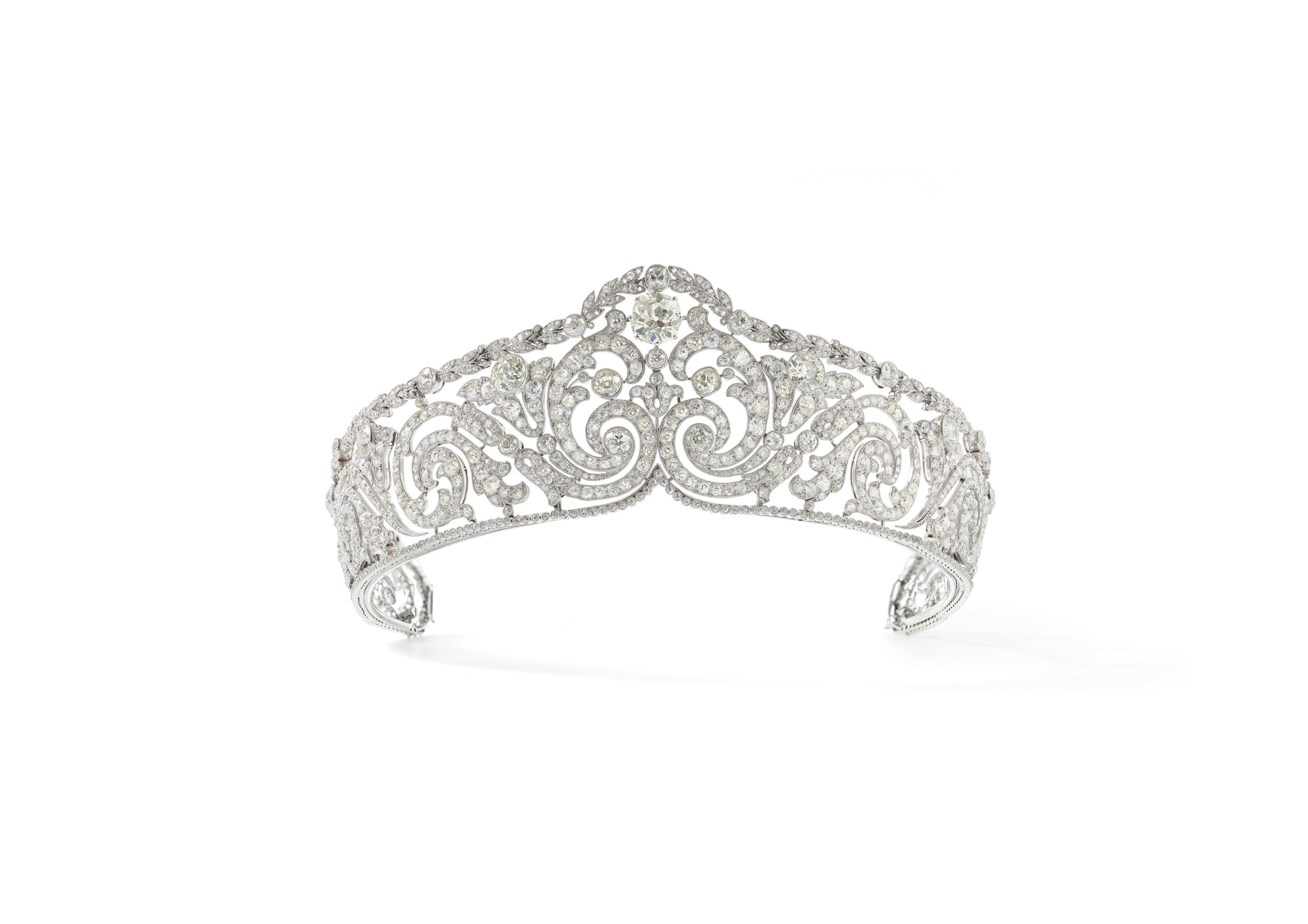
Scroll tiara
Cartier Paris, 1910
Platinum
One cushion-shaped diamond, round old-cut diamonds
Millegrain setting
Sold to Elisabeth, Queen of the Belgians (1876-1965)
Height at centre 5.5 cm
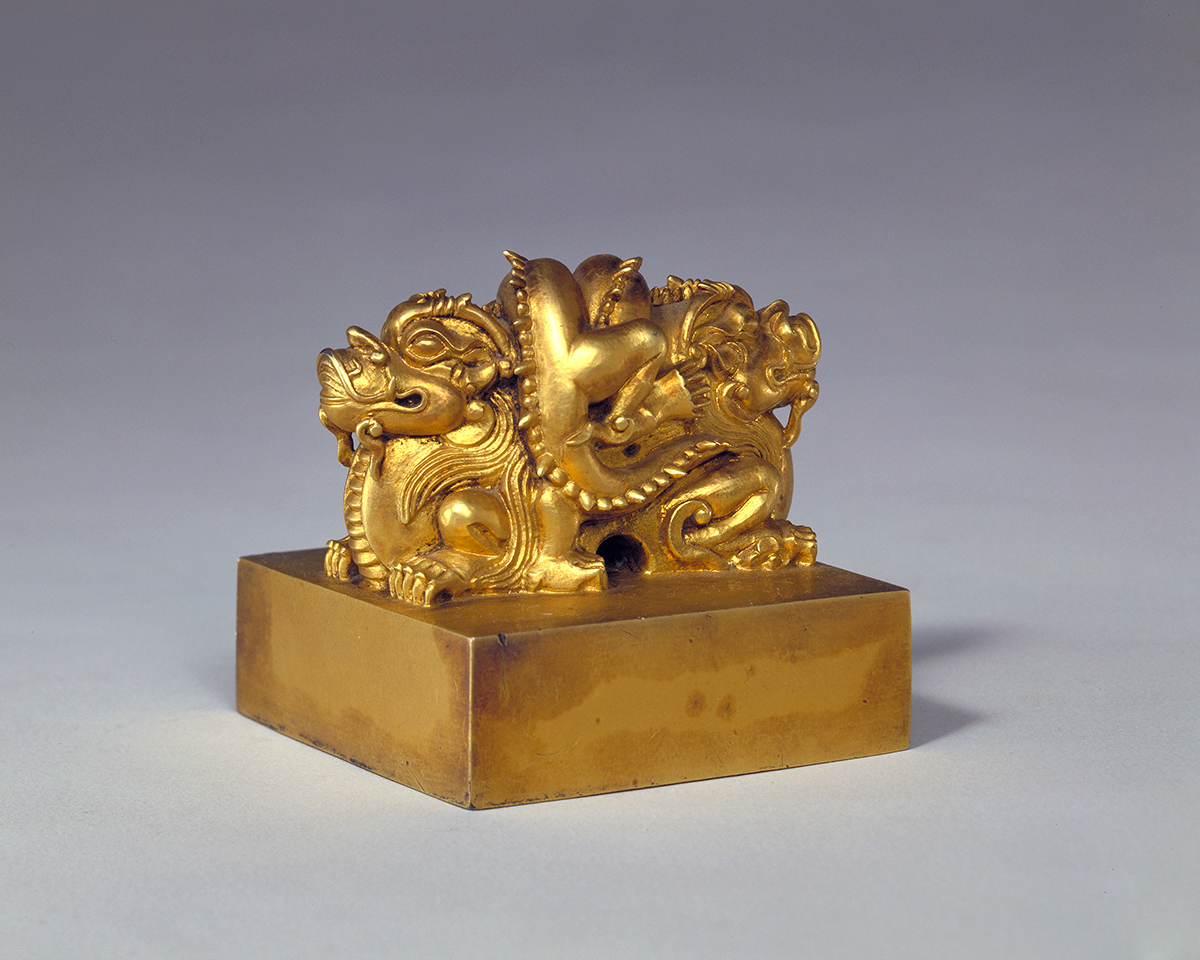
Gold seal with inscription \'Da Qing si Tianzi bao\' (Great Qing Treasure of the Son of Heaven)
Chongde reign (1636-1643), Qing Dynasty (1644-1911)
The Palace Museum Collection
This gold-plated silver imperial seal has a dragon-shaped handle and an inscription on its square face in both Chinese and Manchu scripts. It is ranked third among the twenty-five Qing treasure seals. In the thirteenth year of the Qianlong Emperor\'s reign, the Emperor stated in the Preface to the Treasure Collection of the Hall of Union: \'According to the imperial treasury inventory, this seal\'s script indicates that it was passed down from the Emperor Taizong. The top four treasure seals are inherited from previous emperors and I dare not alter them\'. The first four treasure seals were the white jade seal \'Great Qing Treasure of Receiving the Mandate of Heaven\', the jasper seal \'The Emperor Receives the Mandate of Heaven\', the gold seal \'Great Qing Treasure of the Son of Heaven\' and the green jade seal \'The Emperor\'s Treasure\'. These four imperial seals were treasures from the Taizong period, made after 1636 when Emperor Taiji Chongde officially founded the Qing Empire. Thus the seal \'Great Qing Treasure of Heaven’s Son\' was inherited. The different textures, handle styles and inscribed scripts of the top four seals suggest that they were made in different periods.
Dimension: 7.6 cm x 7.9 cm x 7.9 cm

Time Memories
The development of Cartier watchmaking is inextricably linked to aesthetics and modernity — two concepts that Louis Cartier constantly combined in all of his designs. Throughout the Maison’s history, new kinds of timepieces have been invented, leaving their mark in world jewellery and watchmaking heritage.
In this exhibition, viewers will be able to appreciate Cartier’s timepiece art from multiple angles, while seeing differences in creativity and trends inspired by different time periods and influenced by various styles and inventions.
The Palace Museum adheres to timepiece restoration techniques from the Qing Dynasty court’s Imperial Household Department, which form a legacy of over a century and are now included in China’s national cultural heritage list. Switzerland has for centuries been the cradle of timepiece craftsmanship excellence, and Cartier’s Maison des Métiers d’Art in La Chaux-de-Fond remains committed to its mission of maintaining and preser- ving endangered crafts forms. Benefiting from each other’s strengths and bringing the cultural exchange between East and West into the realm of timepiece preservation, the Palace Museum and Cartier Manufacture have teamed up on a collaborative restoration effort on six of the Palace Museum’s timepieces.
Within boundaries, the solid pace of history presses onward.
Beyond boundaries, the unending search for the vitality of the future continues.

Pocket Watch
Late 18th century, England
Gold-plated Copper
8 x 12 x 4.5 cm
The Palace Museum Collection
This is a double-sided pocket watch with a fusee system and verge escapement.
Dials:
Side 1:
• On an enamel dial, the hours are denoted with Roman numerals, the five-minute marks are in Arabic numerals, and each minute is marked by dots. The lunar calendar dates are denoted with red Arabic numerals.
• The hour and minute hands are in the Beetle & Poker style, and there is another hand to indicate the moon phase.
Side 2:
• On an enamel dial are marks to indicate seconds, while the five-minute marks are in Arabic numerals. Each minute is marked with a line, and between each line are three dots.
• Three subdials:
- On the subdial at the top, the hour marks are in Roman numerals, and the fifteen-minute marks are in Arabic numerals.
- On the calendar subdial (located at about 8 o’clock), Arabic numerals indicate the date for every other day, and between each is a dot.
- On the regulator subdial (located at about 4 o’clock), the even numbers from 2 to 30 are marked with Arabic numerals and interspersed with dots.
• Hands:
- The hour and minute hands are in the Beetle & Poker style.
- The hands for the calendar are of brass or gold.
- The regulator hand is of blackened steel.
- The long second hand in the middle is also of blackened steel
A British balance cock design would not have worked for this double-sided piece. There is a windup handle located at about 11 o’clock (by the hour/minute subdial) that passes through the dial.
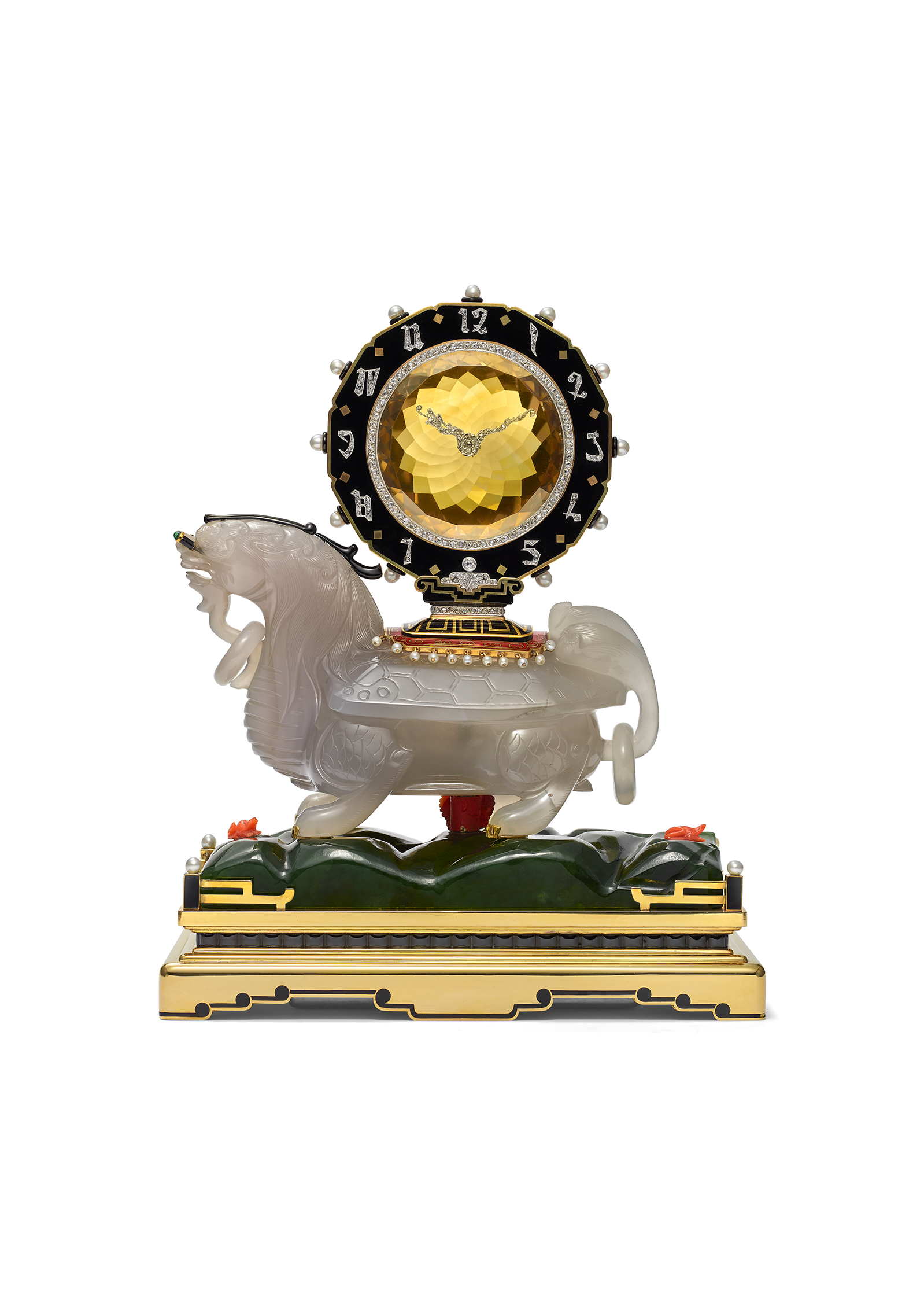
Chimera Mystery Clock
Cartier New York, 1926
Gold, platinum
Carved agate (chimera)
Citrine (dial)
Nephrite (waves)
Rose-cut diamonds, emerald cabochons, pearls, onyx, coral
Red and black enamel
Rectangular 8-day movement, gold-plated, 15 jewels, bimetallic balance, Breguet balance spring
Transmission axle masked by a carved piece of coral beneath the chimera
Hand-setting and winding mechanism underneath the base
The agate chimera, of Chinese origin, dates from the 19th century. This mystery clock was the 6th in a series of 12 that featured animals or figurines, made between 1922 and 1931, partly inspired by Louis XV and Louis XVI clocks in which the clock was set on the back of an animal. Hans Nadelhoffer wrote of these clocks that, like the shrine-gate (Portique) series “although they lacked the symbolism of dynastic commissions associated with Fabergé’s Easter eggs . . . , these figurative ‘mystery clocks’ enjoyed comparable prestige in Cartier’s production and are today considered the most valuable of all collectors’ items with the Cartier signature.” Today the Collection boasts 4 of these wonders: the Carp clock, this one, the Elephant clock and the Deity clock, the last in the series.
Height 17 cm






